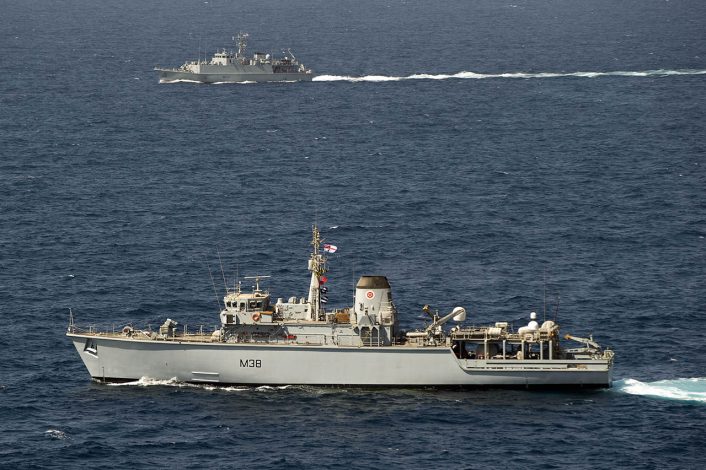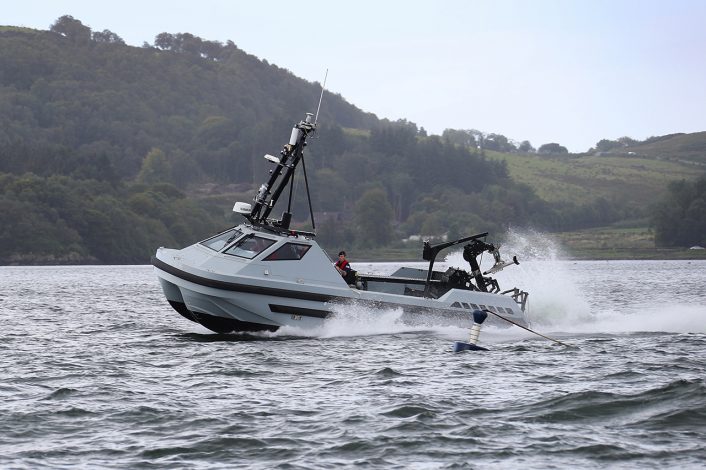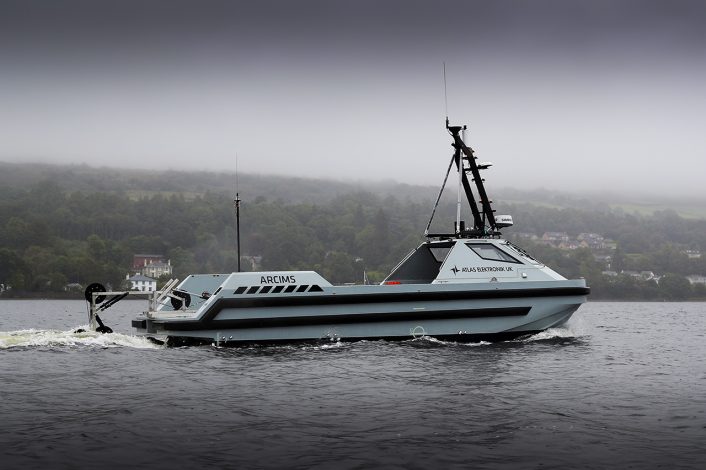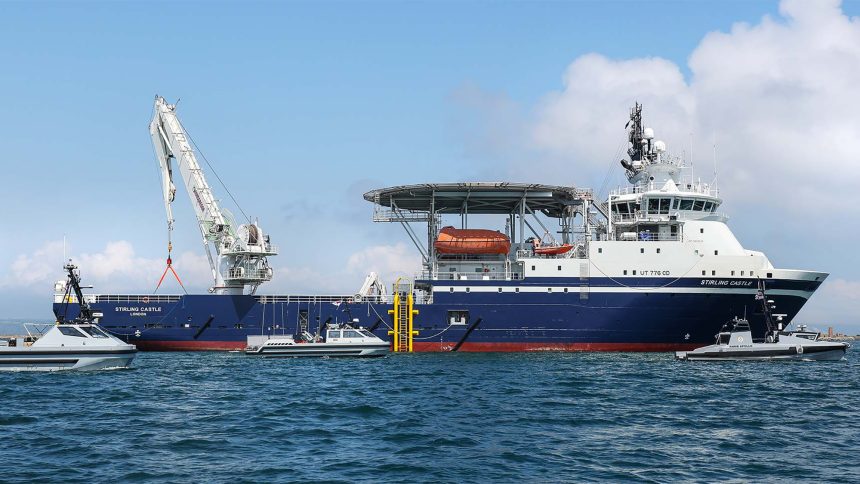Mine countermeasures ‘mothership’ Stirling Castle raised the white ensign on Jul. 25, transferring from the Royal Fleet Auxiliary. The ship is a step towards a new way of countering sea mines, mirrored by other naval forces worldwide.
Procured in 2023 alongside RFA Proteus (K60), Stirling Castle was previously known as MV Island Crown. As Island Crown, the ship was active in a support and supply ship role for offshore energy operations. For this role the 5,800 ton ship was outfitted with a large crane and working deck. To assist with maneuverability, the bow of the ship houses two bow thrusters, and main propulsion is provided by two azipod units that can rotate and provide power in any direction. A third azimuth thruster is mounted towards the bow, retractable into the hull when not required.
All of these features lend themselves well to a new future operating emerging mine countermeasures (MCM) technology, including large unmanned surface and undersea vessels. A more comprehensive overview of the ship’s design can be found from Navy Lookout.
Today is “Super-lift-Saturday” as we approach the pivotal moment in maintenance of our @MacGregorGlobal offshore crane.
Working with our cluster support team and @CammellLaird, our crane will be lifted, realigned and re-secured, ready for future operations 🏗️ ⚓️ pic.twitter.com/06NzwUDFli
— HMS Stirling Castle (@HMS_Str_Castle) April 27, 2024
Originally intended to be operated by the Royal Fleet Auxiliary as RFA Stirling Castle, it was announced in May 2025 that the ship would instead be transferred to the Royal Navy and commissioned as HMS Stirling Castle. Officially, the reasoning for this transfer was down to the ship’s role being considered a frontline tasking and more within the purview of military crews, rather than the civilian crews of the RFA. While this is certainly true to some degree – and previous mine countermeasures vessels (MCMVs) have been operated by the Royal Navy – a more pressing need stems from a major personnel crisis currently crippling the RFA.

Compared to the Sandown and Hunt class MCMVs most recently operated by the Royal Navy (just a handful of these remain active), which both displaced at under 1,000 tons, Stirling Castle is a much larger vessel. This is a reflection of rapidly developing tactics and technologies in the mine countermeasures field.
Rather than the vessel itself taking a direct role in the search for and destruction of sea mines, it will instead act as a hub for smaller, unmanned capabilities that will be deployed from and recovered by the ship. This method of operation has seen some integration onto current MCMVs but the small size of the existing vessels places big limitations on the types of equipment able to be carried.
Emerging Technologies
The Royal Navy has invested in a number of new MCM technologies in recent years. These are mostly focused on uncrewed or optionally crewed surface vessels as well as some undersea units.
Using boats derived from the Sea class workboats now widely employedd by the Royal Navy for training, support, and inshore logistics tasks, the ATLAS Remote Combined Influence Minesweeping System (ARCIMS) is able to be outfitted with various MCM payloads. Facilities are available to operate these as manned vessels if necessary, as well as remotely or completely autonomously.

From the open transom, they can deploy existing capabilities like towed sonar units, the Seacat UUV, and the SeaFox Mine Disposal System, as well as new systems that are under development. By offloading these systems to uncrewed vessels, rather than operating directly from the ship, the Navy can lower the risk of crews being lost in the high risk role of sweeping for and destroying mines at sea. Using a larger vessel to support these autonomous units also allows more to be carried and operated simultaneously, offering a more comprehensive and persistent capability.

ARCIMS boats have already been deployed to the Persian Gulf, where the Royal Navy has maintained a permanent MCMV presence for many years – though this is waning following the withdrawal of the Bay class support ship and thinning out of the MCMV fleet. Further trials on new systems have taken place closer to home, with the SWEEP MCM system having been accepted into service earlier this July.
A crucial milestone…
The #RoyalNavy is now able to deploy crewless minesweeping equipment to hunt and destroy mines for the first time.
Read more: https://t.co/8K0FrBv9d9 pic.twitter.com/jv99ZJ1ybb
— Royal Navy (@RoyalNavy) July 4, 2025
While Stirling Castle and, in the future, new purpose-built MCM support ships, will form the primary MCM capability in the RN, it is noteworthy too that many of these new systems can also be deployed from the multi-purpose mission bays included on the Type 26 and Type 31 frigates. In combination with the planned forward basing of frigates, and the ability for ARCIMS and similar systems to be transported by strategic airlift aircraft, this would allow the Royal Navy to deploy a mine detection and clearance capability to most areas of the world with just a few days of notice.
While Stirling Castle has retained, for now, its helicopter deck, it should be noted that this deck would not be suitable for most types of military helicopter. The layout also does not permit any kind of hangarage for long term support. If kept, though, it could be used to deploy aerial systems with an MCM capability. Small rotary wing unmanned vehicles like the Peregrine could be used as relay systems for operating the autonomous surface/sub-surface vessels. Larger platforms like the Proteus with modular payloads could even accommodate MCM equipment directly, though for long term operation another ship would need to provide shelter and technical facilities.
Airborne MCM is not a new concept, though the RN has not previously adopted it at any significant scale. In the U.S. the MH-60S Seahawk offers a limited MCM capability, while the huge MH-53E Sea Dragon is dedicated to the role with a large towed mine detection sled. The Sea Dragon is slated for retirement by 2027, with no direct replacement in the pipeline. Japan flies a variant of the AW101 Merlin in the MCM role, while South Korea is currently developing a dedicated minehunting helicopter.
Overseas Developments
The UK is not alone in shifting to a ‘mothership’ approach for the MCM mission. Belgium and the Netherlands have partnered to procure a purpose-built ship class of this type, intended for operating uncrewed MCM systems. They will replace the Tripartite class of MCMVs, which are of a similar configuration to the UK’s Hunt and Sandown classes.
Future Belgian Navy City-class mine countermeasures vessels BNS Oostende (M940) and BNS Tournai (M941) and future Royal Netherlands Navy Vlissingen-class mine countermeasures vessel HNLMS Vlissingen (M840) under construction in Concarneau – November 28, 2024
SRC: TW-@pegge49 pic.twitter.com/B9mzrvlwC6
— WarshipCam (@WarshipCam) November 29, 2024
Across the Atlantic, the U.S. have not yet procured a dedicated replacement for its ageing Avenger class of MCMVs. However, in essence, their intended replacement relies on MCM payloads that can be fitted on Independence class and Freedom class littoral combat ships (LCS). The problems with the LCS programme are well known – while the MCM capability marked its first deployment in March 2025, this capability came over ten years behind schedule.
While the shift in methodology is clear, the more traditional style of MCMV still remains viable in many circumstances. Surplus ships retired from Royal Navy service have found a home in the naval forces of Baltic nations, as well as with Ukraine. Ukraine now has two Sandown class and three Tripartite class MCMVs sailing under its flag in Western Europe, awaiting a time where they may safely transfer to Ukrainian waters.
🇺🇦Ukrainian minehunters UNS Chernihiv, UNS Cherkasy, UNS Mariupol and UNS Melitopol alongside in Portland ahead of mine warfare Exercise Sea Breeze 2025-2 (30th June – 11th July)
Via @AytonJustyn pic.twitter.com/VV6SdWQ2U2
— Navy Lookout (@NavyLookout) June 29, 2025
With relatively small crews and operating costs, these MCMVs are useful in maintaining a presence on the waters for these smaller nations without many other naval vessels available. Aside from MCM missions, they can complete coastal and offshore patrol tasks, some survey work, and allow participation in international exercises.









